Living as a pair or group of individuals is an exciting experience for most college students and people who want roommates. However, this experience and harmony can be ruined by the unfair handling of household chores due to different schedules. This is why it is important to have an established framework. A template for a roommate chore chart offers such a framework for dividing these tasks to maintain the premises clean and organized.
Such a template is a fillable and customizable document that helps roommates organize and distribute household chores fairly and efficiently. It serves as a visual representation of the assigned tasks and the schedule for completing them. The goal of using this chart is to promote cooperation, prevent conflicts, and ensure that all roommates contribute equally to maintaining a clean and organized living space.
This article will discuss the fundamental components of a template for crafting a chart for distributing chores among roommates. It also introduces you to the different types of free and printable templates you can use.
Essential Components of an Effective Roommate Chore Chart Template
An effective template should have components that allow you to enlist all the household chores, assign them to respective roommates, and track whether they were completed in due time. By incorporating the essential components into the template, you can create a clear and effective chore-sharing system. Consequently, this encourages cooperation, fairness, and a harmonious living environment among roommates.
Below are the essential components of such a template:
Roommate names
List the names of all roommates at the top of the chart. This makes it clear who is participating in the chore schedule. This information is needed for reference purposes. You can assign numbers or write the initials of the roommates to make it easier to distinguish them from each other.
Chore categories
Secondly, classify the household chores into broad categories to facilitate the organization of the chart and make it easy to navigate it visually. You can categorize the chores based on different house sections such as living room, kitchen, bathroom, or multi-layered tasks.
Chores list
Then list all the household chores and tasks that must be done regularly. This could include cleaning, cooking, organizing, taking out the trash, doing laundry, maintenance, etc. Be comprehensive and cover all essential chores to avoid misunderstandings.
Frequency
In this section, specify how often each chore should be done (daily, weekly, monthly). This depends on the type and sensitivity of the chore. As a result, some chores will have to be done more regularly than others. So, when determining the frequency, base it on the priority of each chore. Also, ensure that chores are not overlapping for any roommate.
Chore assignment
Assign specific chores to each roommate for each day of the week. Before assigning the chores, assess each roommate’s schedule to ensure that the chart does not affect the person’s responsibilities at college or work. Also, rotate tasks regularly to ensure fairness and prevent anyone from being stuck with the same tasks all the time or undertaking a larger portion of the chores.
Due dates
For time-sensitive tasks, set a deadline or due date for completion. You can also set due dates for other chores in order to promote accountability and ensure no tasks are neglected. Having due dates also encourages everyone to complete their assigned chores.
Chore swap/rotation
Next, provide a framework for rotating or swapping assignments regularly to avoid monotony and accommodate unforeseen circumstances. This framework encourages flexibility and understanding among roommates. Sometimes, unexpected events or changes in schedules may require chore adjustments. Be willing to accommodate each other’s needs when possible.
Tracking and reminders
You should track whether chores are being completed. This helps everyone track what’s been done and what still needs to be addressed. You can track these chores using check boxes or initializing when a chore is done to indicate the status of each task (e.g., completed, in progress, not started). Also, consider having a way to send reminders to all the roommates, which can be via smartphone applications or shared calendars.
Penalty/reward system (Optional)
Then consider adding a reward or incentive system to motivate roommates to stay on top of their chores. You can introduce a fee for each overdue chore or an incentive for roommates who finish their chores on time.
Communication channel
Lastly, clarify how the roommates should communicate with each other about chores. You can opt for methods such as leaving notes, using a specific app, using a whiteboard in the common room, or meeting to discuss any issues. You can schedule regular engagements such as weekly or bi-weekly meetings for roommates to review the chart together. This allows everyone to provide feedback, discuss concerns, and make necessary adjustments.
note
You can review the infographic below to learn about all the chores you can include in your chart.
Free Templates
Following are roommate chore chart templates that you can download for free:
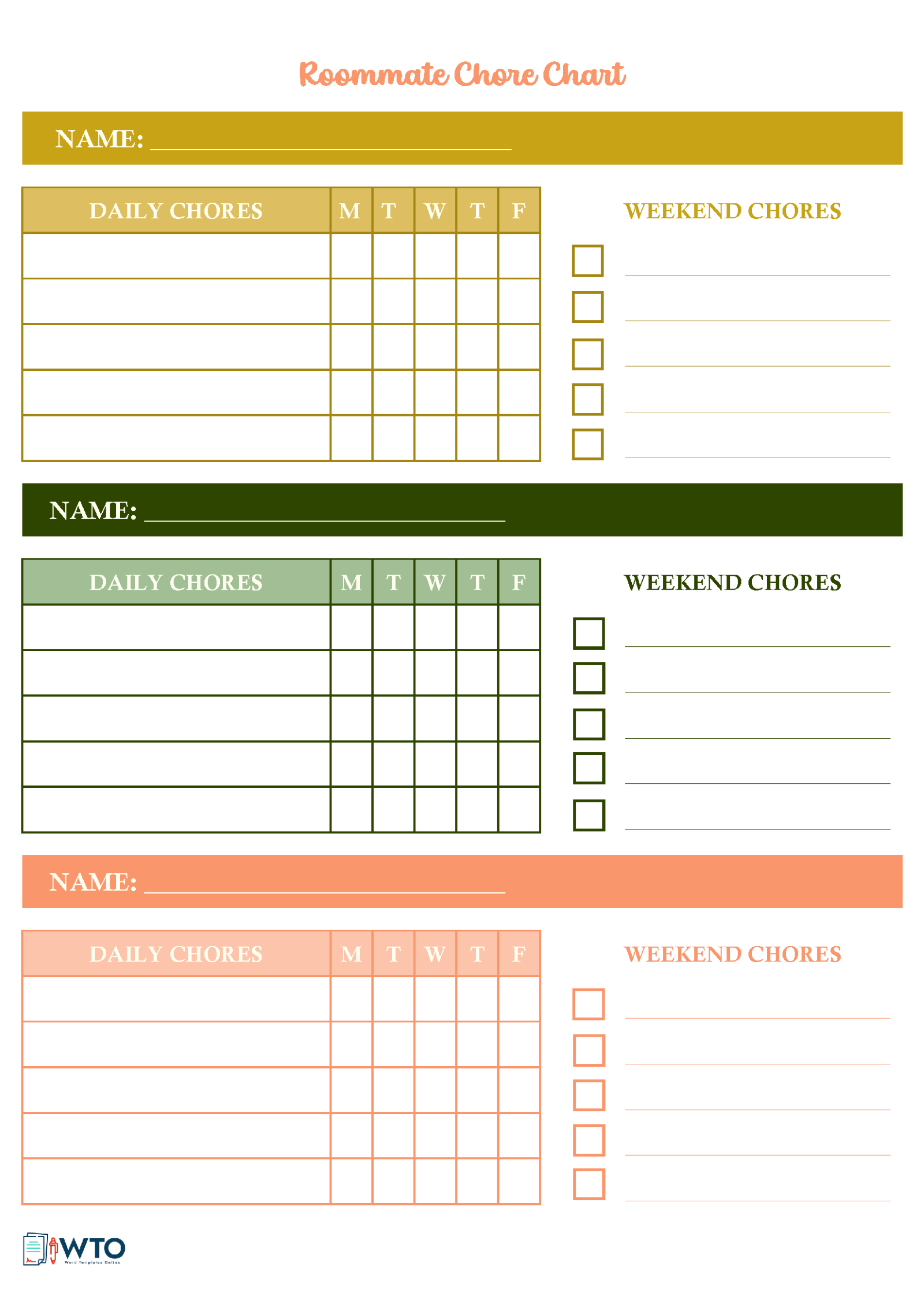

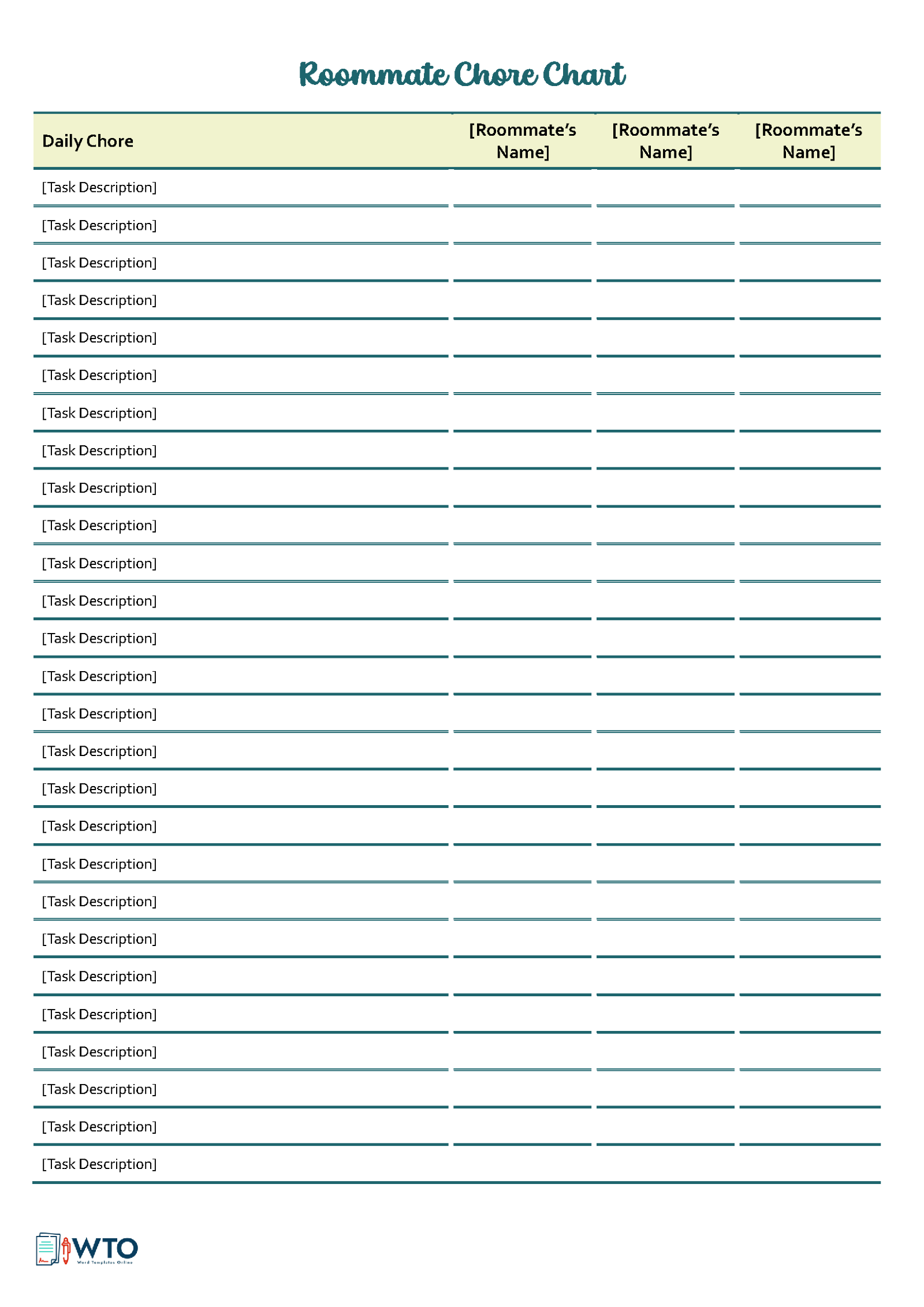
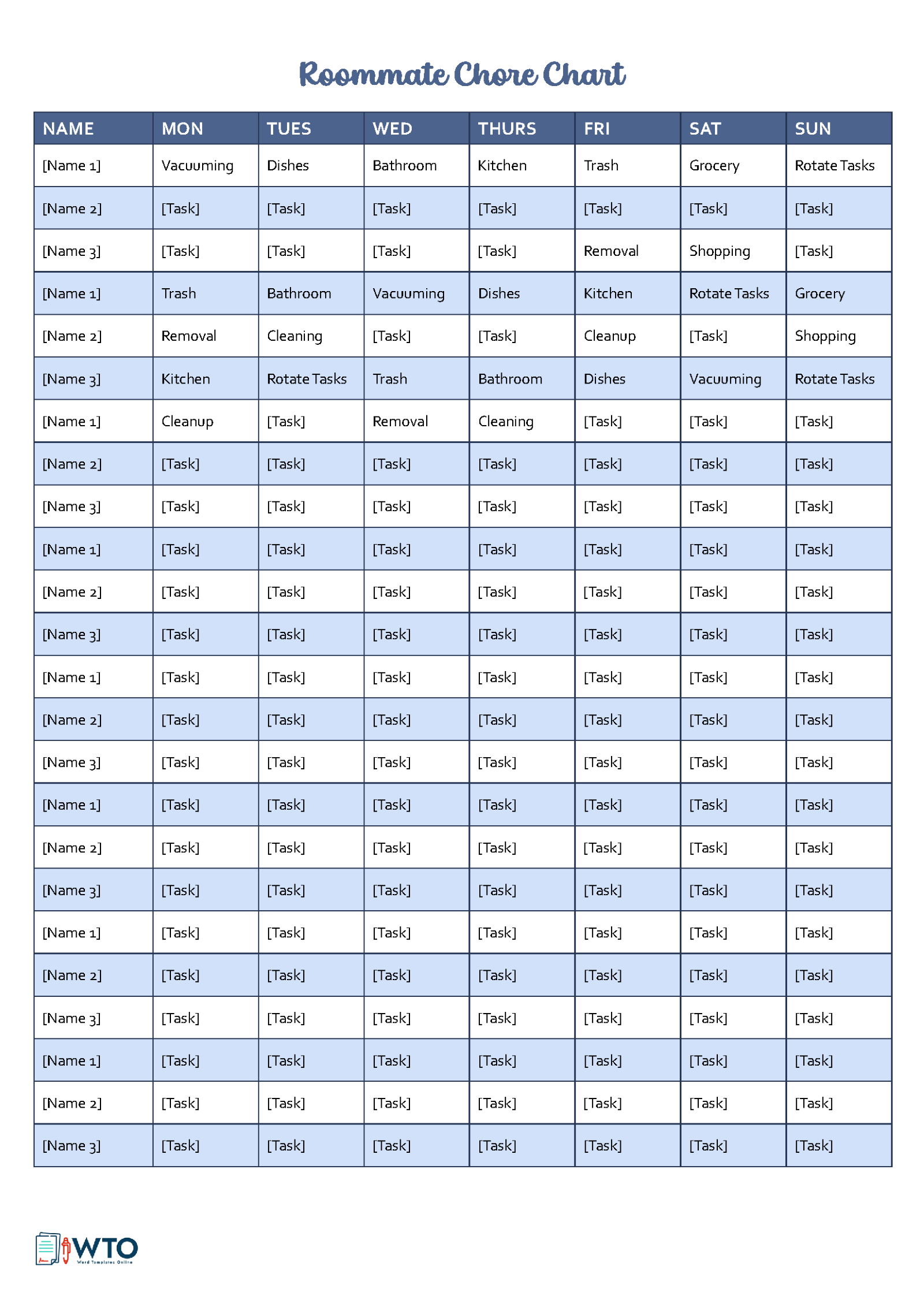
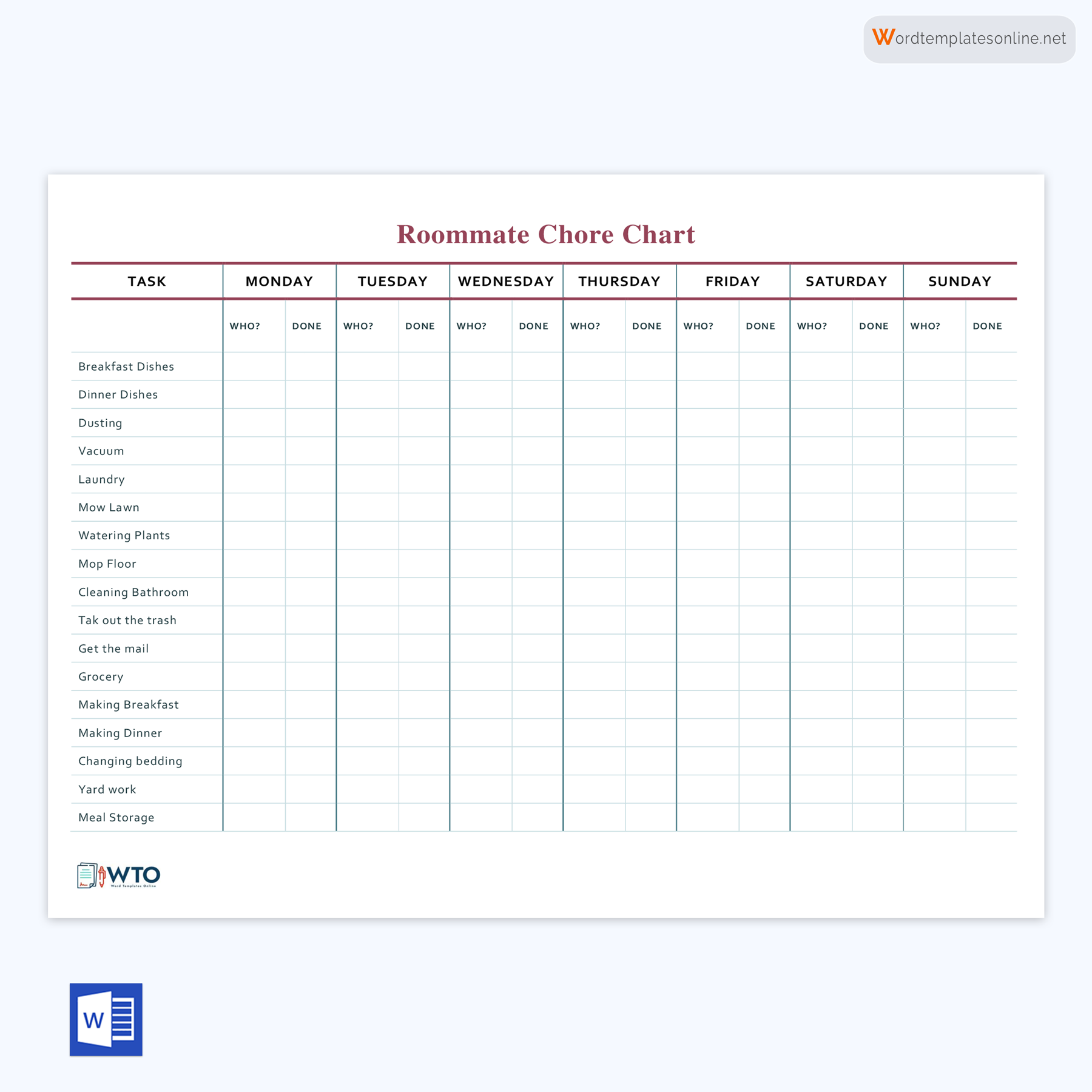
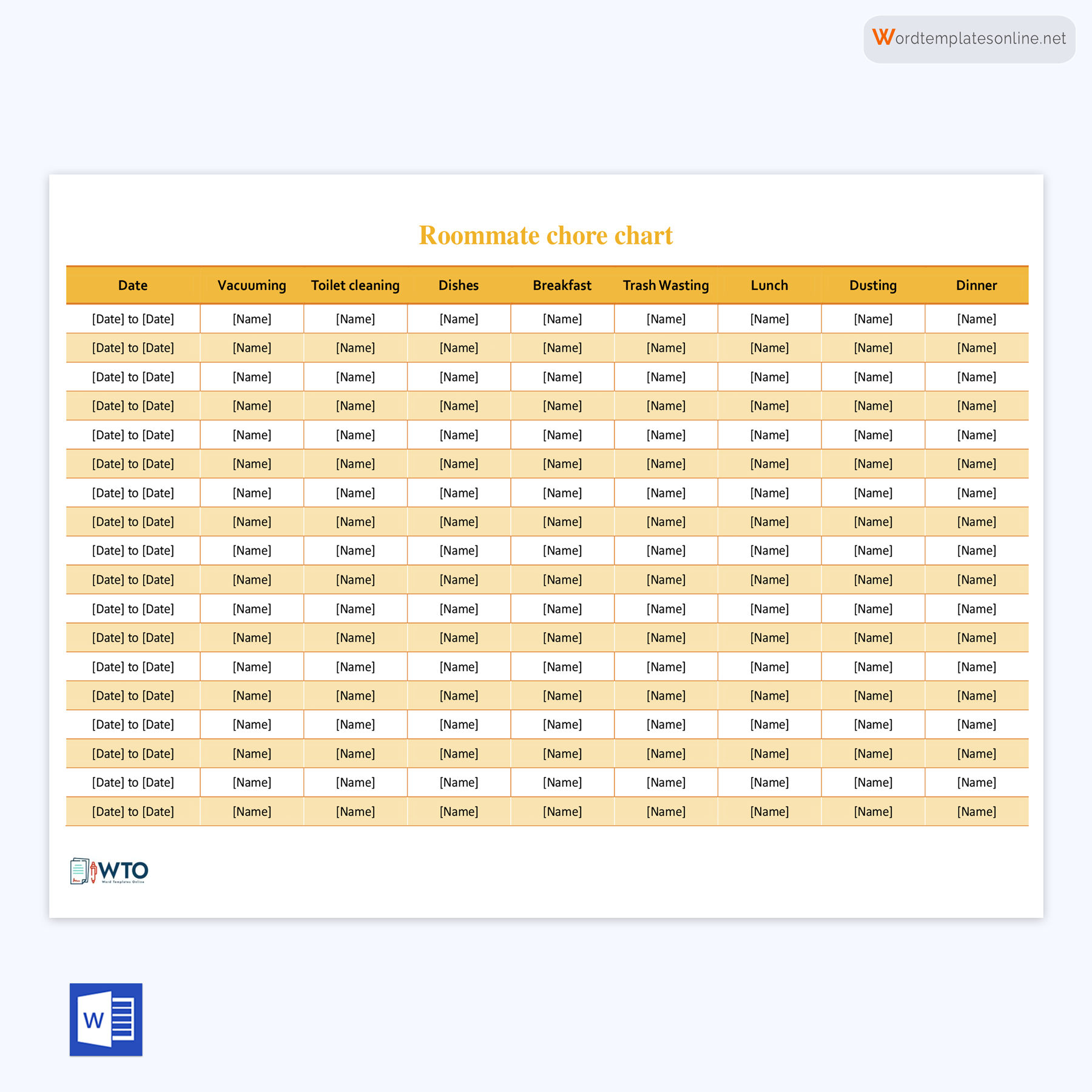
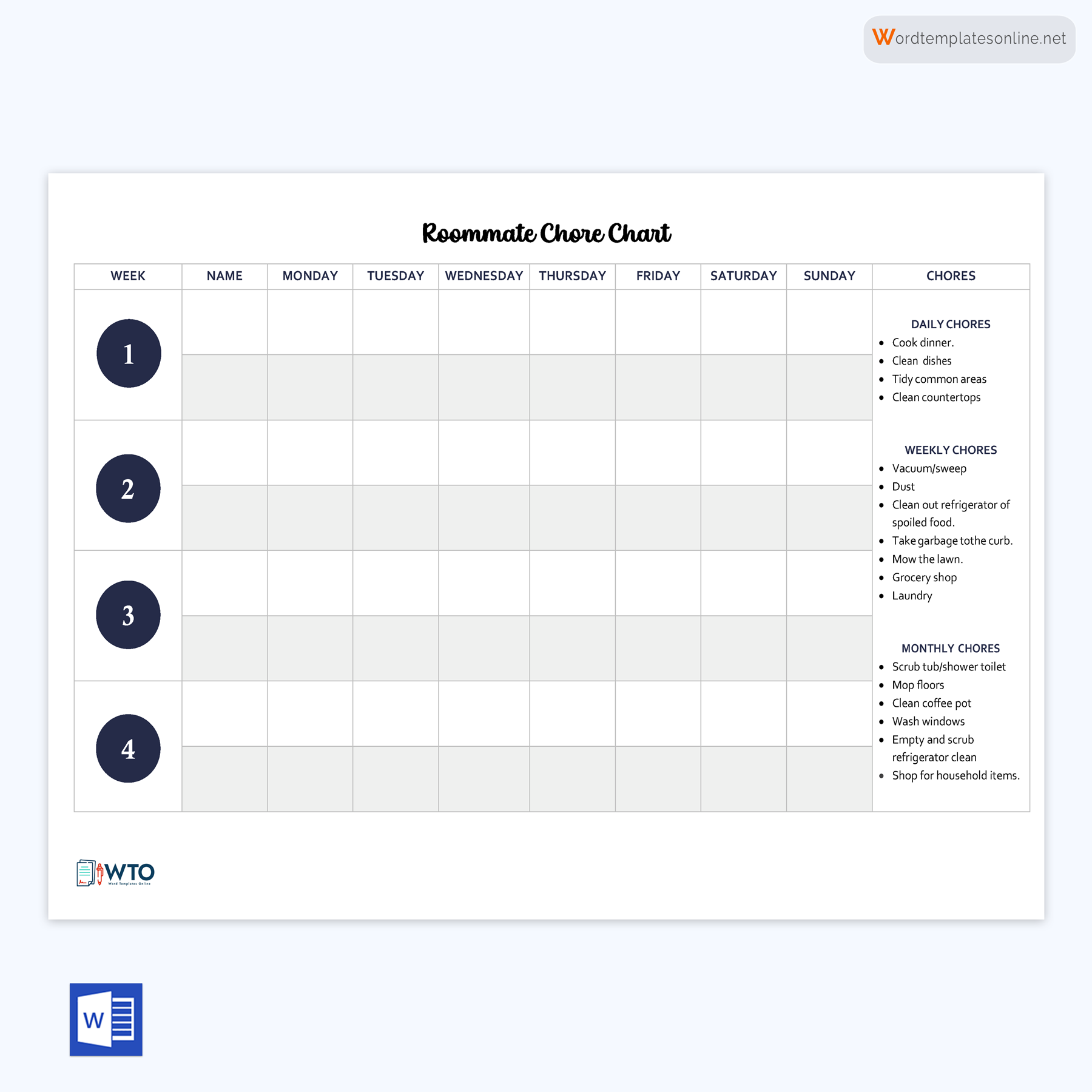
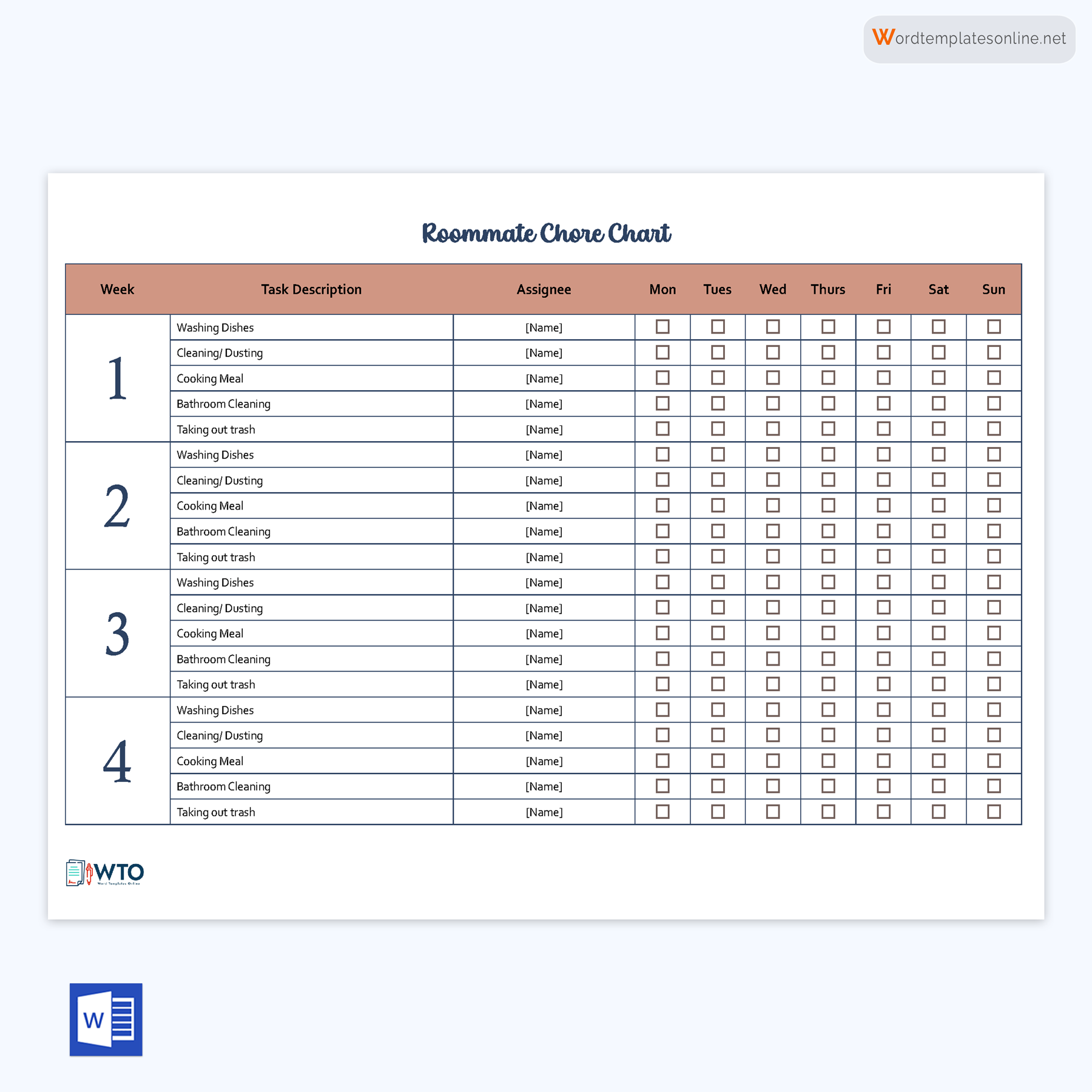
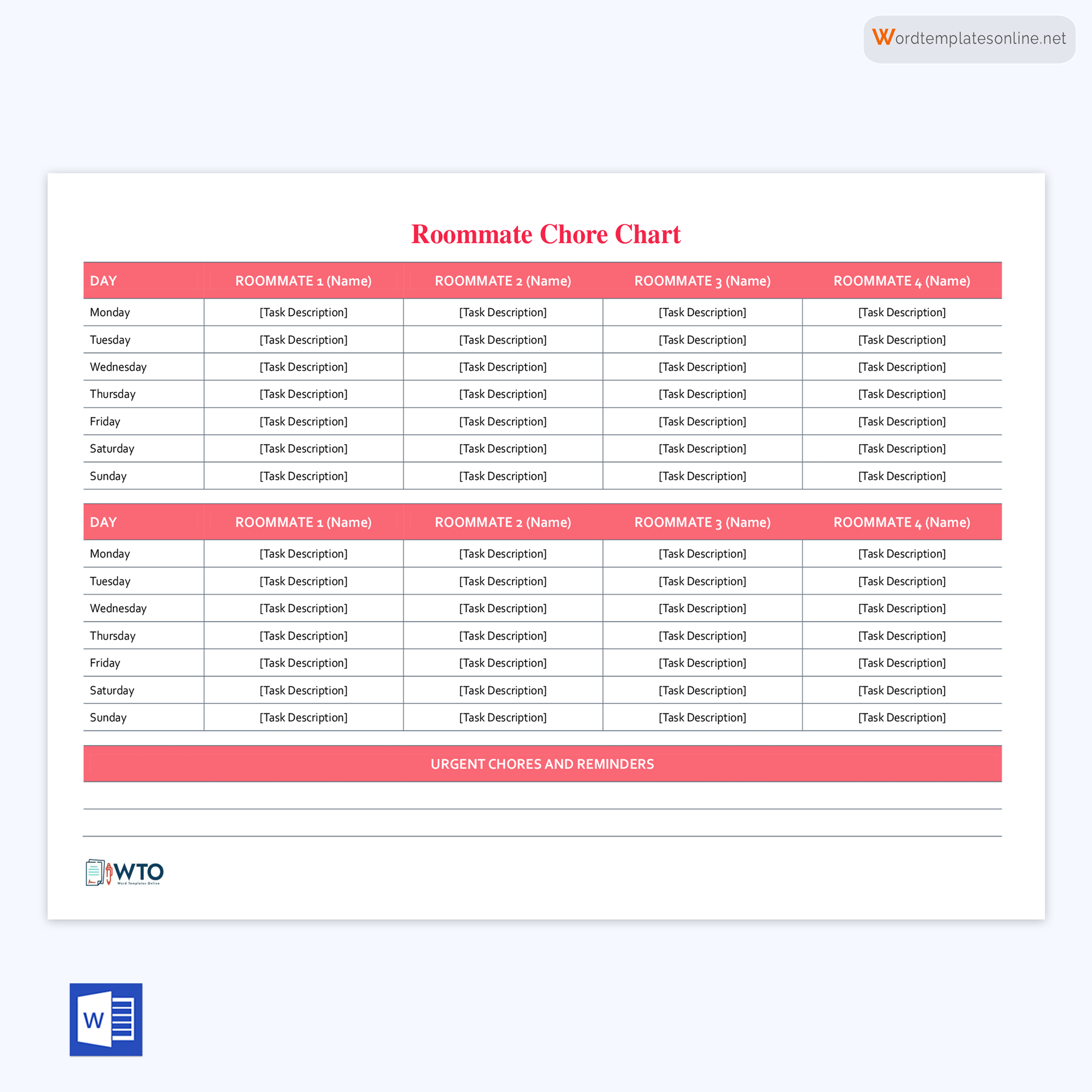
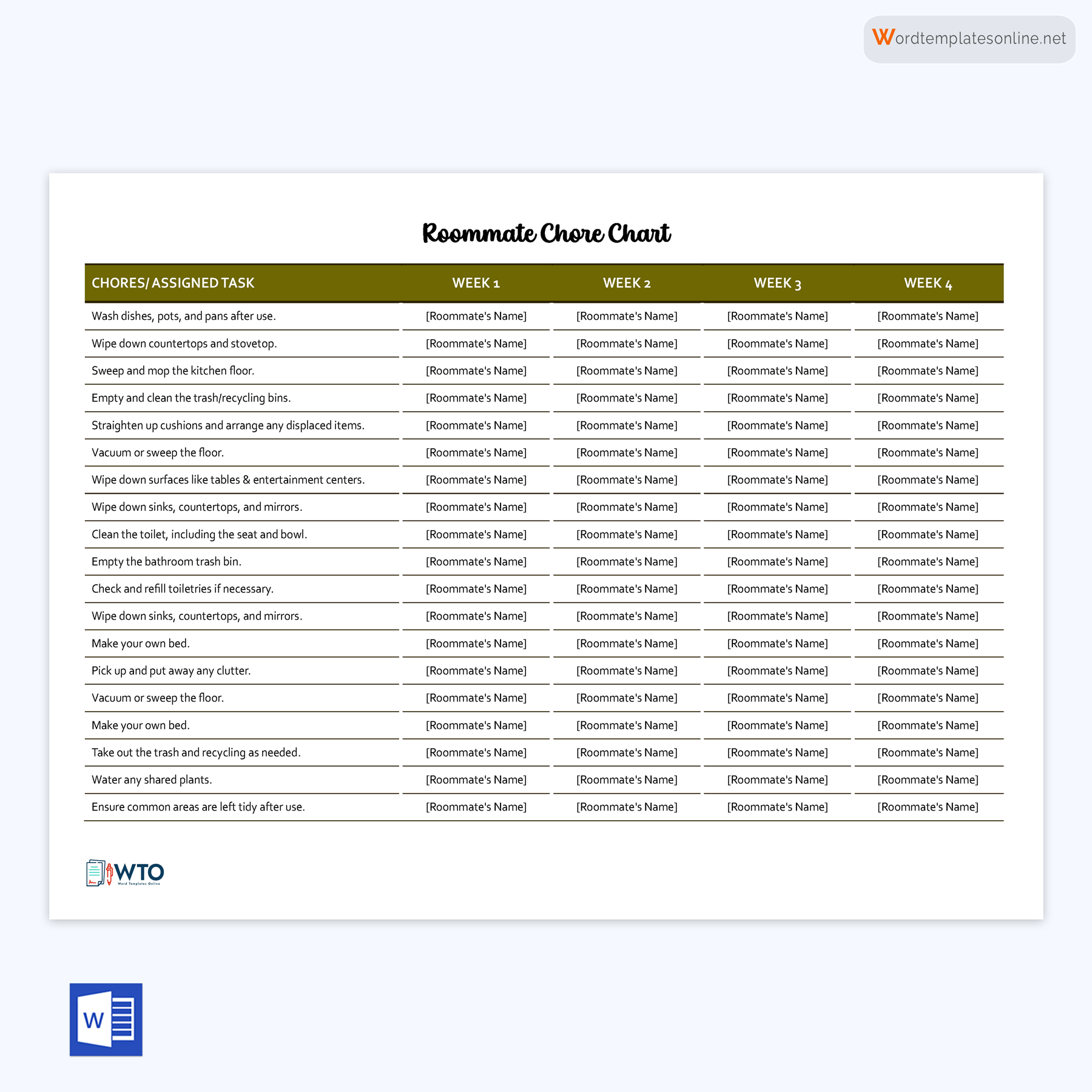
Types of Roommate Chore Chart Templates
There are various types of printable templates for these charts, each designed to fit different living situations, arrangements, and preferences. Despite the differences, the goal is to establish clear expectations and encourage fair distribution of household responsibilities among all roommates.
Here are some common types:
Weekly rotation template
Such a template prompts an arrangement where one roommate is responsible for all the household chores per week. This responsibility is rotated weekly to ensure everyone works equally over time. Such an arrangement breaks the monotony of carrying out the same tasks for a long period. It also provides a sense of consistency and reduces the need for frequent adjustments or discussions about chore assignments, as the schedule automatically rotates.
Task-specific template
A Task-Specific template for the chart focuses on listing all household tasks or chores. It allows roommates to sign up for specific tasks based on their preferences and abilities. This type of template encourages flexibility and empowers roommates to take ownership of the chores they feel most comfortable with. It also fosters efficient and high-standard performance.
Points-based template
This Points-Based template for the chart introduces a reward system where roommates earn points for completing specific tasks. Each task is assigned point values based on difficulty or time requirement. Roommates earn and accumulate points over time by completing the tasks. The amassed points can be redeemed for rewards or incentives agreed upon by all roommates. This approach adds an element of motivation and fun to the chore-sharing process.
Tips for Maintaining an Effective Roommate Chore Chart Template
Maintaining an effective template for creating this chart requires consistent effort and collaboration among all roommates.
Here are some tips to help you keep the chart beneficial and effective in organizing how household chores are handled in a living space:
Regularly review and update the chart template
Set aside a regular time (e.g., weekly or bi-weekly) for roommates to review the current template together. This allows everyone to provide feedback, discuss any concerns, and make adjustments if needed. Also, it ensures the template reflects changes in schedules, preferences, evolving chores, and living arrangements. Then, encourage roommates to update the chart regularly to reflect any changes or swaps in chore assignments.
Communicate openly and address concerns
Keep open communication with your roommates to ensure that everyone is informed of their responsibilities and any changes to the chart. If there are conflicts, issues, or suggestions, address them promptly and respectfully. Effective communication is central to a successful chore distribution arrangement. You can plan for regular meetings to discuss chore-related matters.
Offer flexibility and room for adjustments
Allow roommates to change their chore selections, switch chores and help each other occasionally, especially if circumstances change or there are certain tasks they prefer not to do regularly. So, be open and adjust the chore-sharing system if need be. Should conflicts or unforeseen circumstances arise, let the roommates switch responsibilities or modify the template to make it inclusive.
Recognize and reward efforts
A little appreciation goes a long way in creating a positive living environment and motivating the group. You can do so through verbal appreciation, introducing special privileges, or incentives. If using a points-based system or rewards for completing tasks, make sure to follow through with the agreed-upon incentives.
Final Words
With an organized and fair chore distribution system in place, living with roommates can be an enjoyable and fulfilling experience for all. This is why it is essential to use a predesigned template that guides you on how to structure the chore distribution chart. Also, a template saves you time when recreating the chore chart for each agreed-upon period.
Since there are multiple free and printable templates meant for different chore-sharing arrangements, choose the one that best suits your living situation and preferences. Regularly review and update the template to accommodate changes in schedules or living arrangements, and communicate openly with roommates to address any concerns or conflicts.




